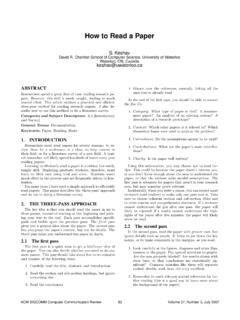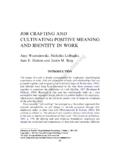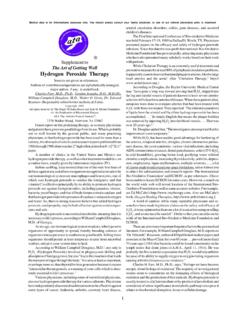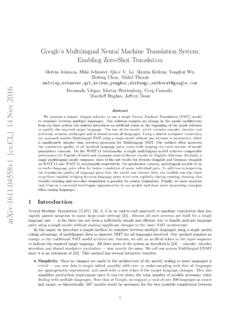Transcription of Wall++: Room-Scale Interactive and Context-Aware Sensing
1 Wall++: Room-Scale Interactive and Context-Aware Sensing Yang Zhang1,2 Chouchang (Jack) Yang1 Scott E. Hudson1,2 Chris Harrison1,2 Alanson Sample1 1 Disney research Pittsburgh 4720 Forbes Ave, Suite 110, Pittsburgh, PA 15213 { , 2 Carnegie Mellon University 5000 Forbes Avenue, Pittsburgh, PA 15213 { , , ABSTRACT Human environments are typified by walls homes, offices, schools, museums, hospitals and pretty much every indoor context one can imagine has walls. In many cases, they make up a majority of readily accessible indoor surface area, and yet they are static their primary function is to be a wall, separating spaces and hiding infrastructure.}}
2 We pre-sent Wall++, a low-cost Sensing approach that allows walls to become a smart infrastructure. Instead of merely separat-ing spaces, walls can now enhance rooms with Sensing and interactivity. Our wall treatment and Sensing hardware can track users touch and gestures, as well as estimate body pose if they are close. By capturing airborne electromagnet-ic noise, we can also detect what appliances are active and where they are located. Through a series of evaluations, we demonstrate Wall++ can enable robust Room-Scale interac-tive and Context-Aware applications. Author Keywords Touch Sensing ; Gestures; Pose Estimation; Indoor Locali-zation; User Identification; Internet of Things; EM Sensing , Context Aware; Smart Environments.
3 ACM Classification Keywords [User interfaces] Input devices and strategies. INTRODUCTION Walls are everywhere, often making up more than half of indoor surface area, especially in residential and office buildings. In addition to delimiting spaces, both for func-tional and social purposes, they also hide infrastructure, such as wiring and HVAC. However, they are generally inactive structural elements, offering no inherent Interactive or computational abilities (other than at small attached silos, , thermostats and light switches), and thus present a tempting opportunity for augmentation, especially consider-ing their ubiquity.
4 In this work, we set out to identify methods that could re-cast walls as smart infrastructure, able to sense interactions and activities happening in a room. In addition to support-ing these broad application domains, we also added process constrains. In particular, we sought a technical approach that was versatile and easy to apply, requiring no special tools ( , CNC machines) or skills ( , carpentry, electri-cal engineering). We also required our approach to be low-cost, so as to be economically feasible at room scale (even a small room, , 2 m, has more than 20 m2 of walls). Finally, we wanted our Sensing approach to be min-imally obtrusive, and ideally invisible.
5 We quickly identified paint as a particularly attractive ap-proach. Walls are already painted, and the average home-owner has the requisite skills to paint a wall. While there are special tools for applying paint ( , brushes, rollers, painter s tape), these are all commodity supplies and readily available at home improvement stores. As we will discuss in greater depth later, we can apply a standard latex topcoat, which allows our technique to be wall-scale, and yet hidden in plain sight. Our ultimately selected method costs ~$20 Permission to make digital or hard copies of all or part of this work for personal or classroom use is granted without fee provided that copies are not made or distributed for profit or commercial advantage and that copies bear this notice and the full cita-tion on the first page.
6 Copyrights for components of this work owned by others than the author(s) must be honored. Abstracting with credit is permitted. To copy other-wise, or republish, to post on servers or to redistribute to lists, requires prior specific permission and/or a fee. Request permissions from CHI 2018, April 21 26, 2018, Montreal, QC, Canada 2018 Copyright is held by the owner/author(s). Publication rights licensed to ACM. ACM 978-1-4503-5620-6/18 $ Figure 1. Wall++ in active mutual capacitive Sensing mode (A) enables touch tracking (B,C) and pose estimation (D,E). Wall++ in passive airborne electromagnetic Sensing mode (F) enables appliance detection and tracking (G,H), as well as user ID (I,J).
7 Per m2 in materials at retail prices. These properties satis-fied all our process criteria. To enable user and environmental Sensing , we drew upon two large bodies of work in the literature. First, we selected mutual capacitive Sensing [8,20,59,65] for close-range in-teractions. Owing to its widespread use in smartphones and tablets, mutual capacitive Sensing is well understood and robust, allowing us to readily adapt it to wall-scale applica-tions. Second, we extended work in airborne electromagnet-ic (EM) Sensing [52,62,78,79]. This required us to develop an electrode pattern that supports both of these Sensing mo-dalities (Figure 1, A & F).
8 For user Sensing , we investigated touch interaction (Figure 1, B & C), pose estimation (D & E), user identification and tracking (I & J). For environment Sensing , we focused on context awareness though appliance recognition and localization (G & H). Collectively, we call our process, materials, patterns, sensor hardware and processing pipeline, Wall++. As we detail in the following pages, optimizing for ease-of-application and reliability, as well as Sensing range and resolution, required iterative experimentation, physical prototyping, simulation modeling and user studies. We believe our resulting system demonstrates new and interesting HCI capabilities and pre-sents a viable path towards smarter indoor environments.
9 RELATED WORK Our work intersects with three key literatures. First, we discuss prior work that enables Room-Scale touch tracking. We then review Room-Scale approaches for tracking user location and pose. We conclude with systems able to detect and track objects. In particular, we focus primarily on sys-tems that are deployed in the environment, as opposed to those that are carried ( , smartphones, wearables). Room-Scale Touch Most previous systems have achieved wall-scale touch Sensing through optical approaches. For example, La-serWall [53] used a scanned laser rangefinder operating parallel to a wall s surface to detect hand touches.
10 Infrared emitter-detector arrays have also been used to create large Interactive surfaces [44]. Most popular are camera-based approaches, including invisible light [60], depth [7,30,74, 75,76], and even thermal imaging [37]. People have also explored acoustic touch Sensing approach-es, for example, by attaching microphones to the corners of a desired Interactive surface and using time difference of arrival methods [29,54]. It is also possible to use an array of centrally located acoustic sensors for estimating the loca-tion of tap events [77]. Researchers have also forgone abso-lute spatial tracking, and instead built interactions around gesture vocabularies [27].





